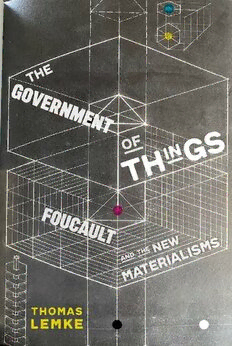Table Of ContentThe Government of Things
The Government of Things
Foucault and the New Materialisms
Thomas Lemke
NEW YORK UNIVERSITY PRESS
New York
NEW YORK UNIVERSITY PRESS
New York
www.nyupress.org
© 2021 by New York University
All rights reserved
References to Internet websites (URLs) were accurate at the time of writing. Neither the
author nor New York University Press is responsible for URLs that may have expired or
changed since the manuscript was prepared.
Library of Congress Cataloging-in-Publication Data
Names: Lemke, Thomas, author.
Title: The government of things : Foucault and the new materialisms / Thomas Lemke.
Description: New York, N.Y. : NYU Press, 2021. | Includes bibliographical references
and index.
Identifiers: LCCN 2021003107 | ISBN 9781479808816 (hardback) |
ISBN 9781479829934 (paperback) | ISBN 9781479810536 (ebook) |
ISBN 9781479890712 (ebook other)
Subjects: LCSH: Foucault, Michel, 1926–1984—Political and social views. |
Political science—Philosophy. | Philosophy and education.
Classification: LCC JC261.F68 L46 2021 | DDC 320.01—dc23
LC record available at https://lccn.loc.gov/2021003107
Chapters 1 and 2 are based on previously published material: “Materialism Without Matter:
The Recurrence of Subjectivism in Object- Oriented Ontology,” Distinktion: Journal of Social
Theory 18(2), 2017: 133– 152; and “An Alternative Model of Politics? Prospects and Problems
of Jane Bennett’s Vital Materialism,” Theory, Culture & Society 35(6), 2018: 31–5 4. Reprinted
by the permission of the publishers.
New York University Press books are printed on acid- free paper, and their binding materials
are chosen for strength and durability. We strive to use environmentally responsible suppli-
ers and materials to the greatest extent possible in publishing our books.
Manufactured in the United States of America
10 9 8 7 6 5 4 3 2 1
Also available as an ebook
There is thus a tendency for any materialism, at any point in
its history, to find itself stuck with its own recent generaliza-
tions, and in defence of these to mistake its own character:
to suppose that it is a system like others, of a presumptive
explanatory kind, or that it is reasonable to set up contrasts
with other (categorical) systems, at the level not of proce-
dures but of its own past “findings” or “laws.” What then
happens is obvious. The results of new material investi-
gations are interpreted as having outdated “materialism.”
(Williams 1980, 103)
I think that you are completely free to do what you like
with what I am saying. These are suggestions for research,
ideas, schemata, outlines, instruments; do what you like
with them. [ . . . ] I could tell you that these things are trails
to be followed, that it didn’t matter where they led, or even
that the one thing that did matter was that they didn’t lead
anywhere, or at least not in some predetermined direction.
I could say they were like an outline for something. It’s up
to you to go on with them or to go off on a tangent [ . . . ].
(Foucault 2003, 2, 4)
Contents
Introduction 1
Part I: Varieties of Materialism 19
1. Immaterialism: Graham Harman and the Weirdness
of Objects 21
2. Vital Materialism: Jane Bennett and the Vibrancy of Things 40
3. Diffractive Materialism: Karen Barad and the Performativity
of Phenomena 57
Part II: Elements of a More- Than- Human
Analytics of Government 79
4. Material- Discursive Entanglements: Grasping the Concept
of the Dispositive 81
5. More- Than- Social Configurations: Expanding the
Understanding of Technology 103
6. Beyond Anthropocentric Framings: Circulating the Idea
of the Milieu 121
Part III: Toward a Relational Materialism 141
7. Aligning Science and Technology Studies and an Analytics
of Government 144
8. Environmentality: Mapping Contemporary
Political Topographies 168
Conclusion: Multiple Materialisms 191
Acknowledgments 203
Notes 207
Bibliography 249
Index 289
About the Author 301
Introduction
Materialism is a rich philosophical tradition that goes back to antiquity.
It started with the works of Democritus and Lucretius, was taken up and
rearticulated in modern philosophy in the writings of Hobbes, Spinoza,
and many others, and flourished in the nineteenth and twentieth cen-
turies, especially due to the achievements of the natural sciences and
the rise of Marxism (see, e.g., Braun 1982; Lange 2010). While material-
ist thought always had an important critical role in contesting different
versions of idealism and spiritualism, its impact went well beyond aca-
demic disputes and intellectual debates. It not only denoted a position
in a philosophical controversy but also figured prominently in popular
discourse. Interestingly, “materialists” suffered from a bad reputation
both in the world of theory and in the view of common sense. For cen-
turies they were regarded as people of questionable character who did
not believe in God, adhered to dubious morals, and expressed danger-
ous thoughts: an “evil sect” (“schlimme Sekte”), as an important German
encyclopedia put it in the eighteenth century (Zedler 1739, 2026; see also
Post and Schmidt 1975, 7).1
Things have changed today. At least in academia, materialism has
become something respectable, serious, and even fashionable. And
“things” have played a decisive role in this transformation: materials,
artifacts, and objects are increasingly attracting scientific interest and
are being freshly conceptualized. The past two decades have seen a re-
markable development in the social sciences and the humanities: the
rise of new materialisms (see, e.g., Hird 2004; Coole and Frost 2010a;
Dolphijn and van der Tuin 2012).2 Theoretical perspectives and empiri-
cal studies that focus on the diverse and plural forms of materiality are
complementing or replacing research on social constructions, cultural
practices, and discursive processes. New materialist scholarship shares
the conviction that the “linguistic turn” or primarily textual accounts
are insufficient for an adequate understanding of the complex and dy-
1

